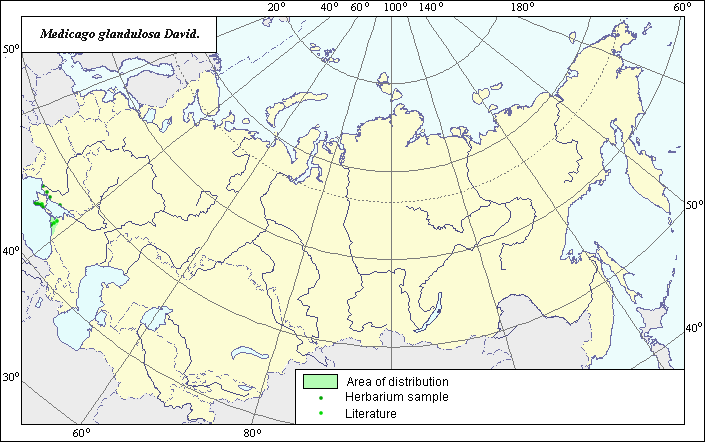Relatives
Distribution area of glandulous medic (Medicago glandulosa David.).
 Object description Download GIS-layers
Object description Download GIS-layers
Authors:
Experts N.I. Dzyubenko & E.A. DzyubenkoGIS-expert A.N. Dzyubenko
Date of creation:
17.05.2005.Scale:
1:20,000,000.Exactness of map:
The map was created using a map of scale 1:60,000,000.The projection:
"Alber's Equal Area Conic for Russia", 9, 1001, 7, 100, 0, 44, 68, 0, 0.Basic contents:
Map is a vector file consisting of polygons and points. Locations of the species are represented by points, while the area of possible distribution of the species is represented by polygons.Exactness of classifier:
Light-colored points represent species locations referenced in published sources. Dark-colored points represent species locations reported in the VIR database (N.I. Vavilov All-Russian Research Institute of Plant Industry) and BIN database (Komorov Institute of Botany). Polygons are based on published sources, herbarium samples, political boundaries and ecological descriptions.Method of map construction:
To construct the distribution area of Medicago glandulosa, published maps of the area (Vasil.chenko, 1949) and herbaria data (Komarov Botanical Institute (BIN), N.I. Vavilov All-Russian Institute of Plant Industry (VIR), St. Petersburg) were used. The species originated in Southeastern Europe and the Mediterranean basin areas. Its distribution area covers the European part of the former USSR, the Caucasus and the Crimea, which constitute the southeastern part of the species distribution area. The map was created by generalizing data into two polygons (green line). The Crimean polygon is situated in the mountainous part of the Crimea. The Caucasian polygon is situated on the northern part of the Black Sea Coast. The distribution area borders are based on all available data -- both verified species locations and published data (Phyodorov, 1987; Goncharov & Lubenetc, 1985; Grossheim, 1945, 1952; Ivanov, 1980; Sinskaya, 1950). The points not included in the polygons represent single sites of the species. The distribution area borders take into account the ecological preferences of the species.Sources of data:
Database of the VIR materials (N.I. Vavilov All-Russian Institute of Plant Industry) and BIN materials (the Komorov Institute of Botany).Goncharov P.L., Lubenetc P.A. 1985. Biological Aspects of Alfalfa Cultivating. Novosibirsk: Nauka, 253 pp. (in Russian).
Grossheim A.A. 1952. Genus Medicago. Flora of the Caucasus. Vol. 5. M.-L.: Academy of Science of the USSR, p. 177-192. (in Russian).
Grossheim A.A. 1945. Genus Medicago. Flora of the USSR. Vol. 11. M.-L.: USSR, p. 129-176. (in Russian).
Ivanov A.I. 1980. Alfalfa. M.: Kolos, 349 pp.
Phyodorov A.A., ed. 1987. Flora of the European part of the USSR. Vol. 6. 254 pp. (in Russian).
Sinskaya E.N. 1950. Alfalfa. Flora of cultivated plants of the USSR. Vol. 13. M.-L.: Issue 1. p. 1-344. (in Russian).
Vasil.chenko I.T. 1949. Alfalfa as the best fodder crop. L.: Academy of Science of the USSR, Ser. 1. Issue 8. 248 pp.
Rights and copyrights:
Copyright on the map and its descriptions belong to its authors.Copyright on the photos belongs to N.I. Dzyubenko.

